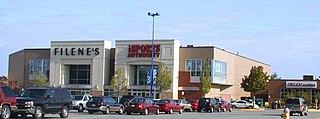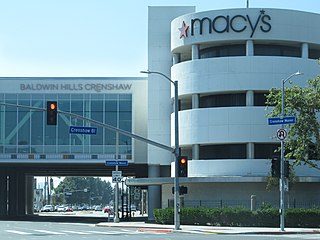KCET is a secondary PBS member television station in Los Angeles, California, United States. It is owned by the Public Media Group of Southern California alongside the market's primary PBS member, Huntington Beach–licensed KOCE-TV. The two stations share studios at The Pointe in Burbank; KCET's transmitter is located atop Mount Wilson in the San Gabriel Mountains.

Hamleys is a British multinational toy retailer, owned by Reliance Retail. The world's oldest toy store, it was founded by William Hamley as "Noah's Ark" in High Holborn, London, in 1760. It moved to its current site on Regent Street in London's West End in 1881. This flagship store is set over seven floors, with more than 50,000 lines of toys on sale. It receives around five million visitors each year.
Waldenbooks, operated by the Walden Book Company, Inc., was an American shopping mall-based bookstore chain, from 1995 as a subsidiary of Borders Group. The chain also ran a video game and software chain under the name Waldensoftware, as well as a children's educational toy chain under Walden Kids. In 2011, the chain was liquidated in bankruptcy.

Gimbel Brothers was an American department store corporation that operated for over a century, from 1842 until 1987. Gimbel patriarch Adam Gimbel opened his first store in Vincennes, Indiana, in 1842. In 1887, the company moved its operations to the Gimbel Brothers Department Store in Milwaukee, Wisconsin. It became a chain when it opened a second, larger store in Philadelphia, Pennsylvania, in 1894, moving its headquarters there. At the urging of future company president Bernard Gimbel, grandson of the founder, the company expanded to New York City in 1910.

Merry Hill is a large shopping complex in Brierley Hill near Dudley, England. It was developed between 1985 and 1990, with several subsequent expansion and renovation projects. The centre is anchored by Marks & Spencer, Primark, Asda, Next and formerly Debenhams.
The Paseo is an outdoor mall in Pasadena, California, covering three city blocks with office space, shops, restaurants, a movie theater, and 400 loft-style condominiums above.

The Grove is a retail and entertainment complex in Los Angeles, located on parts of the historic Farmers Market.
K·B Toys was an American chain of mall-based retail toy stores. The company was founded in 1922 as Kaufman Brothers, a wholesale candy store. The company opened a wholesale toy store in 1946, and ended its candy wholesales two years later to emphasize its toy products. Retail sales began during the 1970s, using the name Kay-Bee Toy & Hobby.

Santa Monica Place is an outdoor shopping mall in Santa Monica, California. The mall is located at the south end of Santa Monica's Third Street Promenade shopping district, two blocks from the beach and Santa Monica Pier. The mall originally opened in 1980 as an indoor mall, and underwent a massive, three-year reconstruction process beginning in January 2008 and re-opened as an outdoor shopping mall on August 6, 2010. The mall spans three levels. The mall also features the traditional retailer Nordstrom. The mall's tenant mix is predominantly upscale, featuring Tiffany & Co., Louis Vuitton, Tory Burch, Elie Tahari, and AllSaints.

White Front was a chain of discount department stores in California and the western United States from 1959 through the mid-1970s. The stores were noted for the architecture of their store fronts which was an enormous, sweeping archway with the store name spelled in individual letters fanned across the top.
The William H. Block Company was a department store chain in Indianapolis and other cities in Indiana. It was founded in 1874 by Herman Wilhelm Bloch, an immigrant from Austria-Hungary who had Americanized his name to William H. Block. The main store was located at 9 East Washington Street in Indianapolis in 1896. The company also identified itself as The Wm. H. Block Co., and Block's.

May Company California was a chain of department stores operating in Southern California and Nevada, with headquarters in North Hollywood, California. It was a subsidiary of May Department Stores and merged with May's other Southern California subsidiary, J. W. Robinson's, in 1993 to form Robinsons-May.

The Maine Mall is an enclosed shopping mall in South Portland, Maine, United States. Owned and managed by Brookfield Properties, it is the largest shopping mall in the state of Maine, and the second-largest in northern New England, behind New Hampshire’s The Mall at Rockingham Park.

Baldwin Hills Crenshaw Plaza is a shopping mall located in the Baldwin Hills neighborhood of Los Angeles, California. This was one of the first regional shopping centers in the United States built specifically for the automobile. Two anchor buildings, completed in 1947, retain their original Streamline Moderne style. Since the mid-1960s, the mall has become a major economic and cultural hub of surrounding African American communities which include a spectrum of socioeconomic classes.
CenterMark, formerly known as May Centers, was a mall development company owned by a consortium of Westfield Holdings Ltd., General Growth Properties, and Whitehall Street Real Estate L.P. III. And it was formerly owned by The May Department Stores Company until 1992, and Prudential Insurance until 1993.
Los Altos Center is a regional shopping mall in the Los Altos area of northeastern Long Beach, California along Bellflower Boulevard, 4 miles south of Lakewood Center Mall and 5 miles east of Downtown Long Beach.

Retail in Southern California dates back to its first dry goods store that Jonathan Temple opened in 1827 on Calle Principal, when Los Angeles was still a Mexican village. After the American conquest, as the pueblo grew into a small town surpassing 4,000 population in 1860, dry goods stores continued to open, including the forerunners of what would be local chains. Larger retailers moved progressively further south to the 1880s-1890s Central Business District, which was later razed to become the Civic Center. Starting in the mid-1890s, major stores moved ever southward, first onto Broadway around 3rd, then starting in 1905 to Broadway between 4th and 9th, then starting in 1915 westward onto West Seventh Street up to Figueroa. For half a century Broadway and Seventh streets together formed one of America's largest and busiest downtown shopping districts.

Lakeshore Learning Materials is a chain of educational supply stores. The company is one of the largest retail and online suppliers of educational materials to teachers with more than 60 stores in 29 states. The company is based in Carson, California and employs more than 2000 people.










